Early ripe hybrid of cucumbers "Bettina" for greenhouses, open ground and growing on a windowsill
The Dutch hybrid of Bettina cucumbers has a number of positive features and stands out noticeably among other crops. The bushes produce tasty and healthy fruits in a short time, are resistant to temperature changes and diseases, and are easy to care for.
Description of cucumbers
The first generation hybrid Bettina was bred by Dutch breeders relatively recently, in 2007. Initially, employees sought to develop cucumbers that would produce high yields even in unfavorable climatic conditions.
As a result, scientists achieved not only their goals, but also created a record holder in terms of crop ripening. Bettina was added to the State Register of the Russian Federation in 2010.
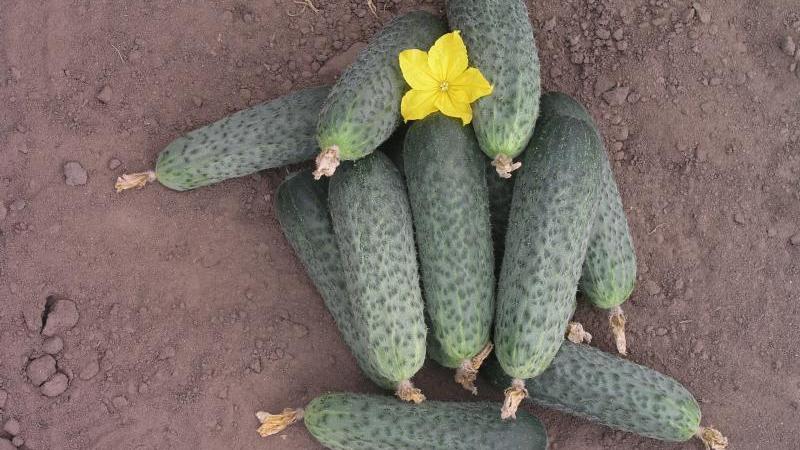
Peculiarities
Type of gherkin cucumbers. The hybrid is successfully grown both in open ground and in greenhouse conditions, even on window sills or balconies. The culture is parthenocarpic (self-pollinating). This simplifies the cultivation of vegetables in closed structures where pollinating insects do not enter.
Bushes show the best yield in mild climatic conditions, but tolerate temperature fluctuations well.
Composition and properties
The fruits consist of 90–95% structured water, so they perfectly quench thirst. They contain a large amount of minerals and vitamins A, B1, B2, C, E, RR, N.
Vegetables include:
- phosphorus;
- sodium;
- potassium;
- fructose;
- glucose;
- magnesium;
- calcium;
- iodine;
- carotene;
- starch.
The fruits also contain caffeic, ascorbic and folic acids.
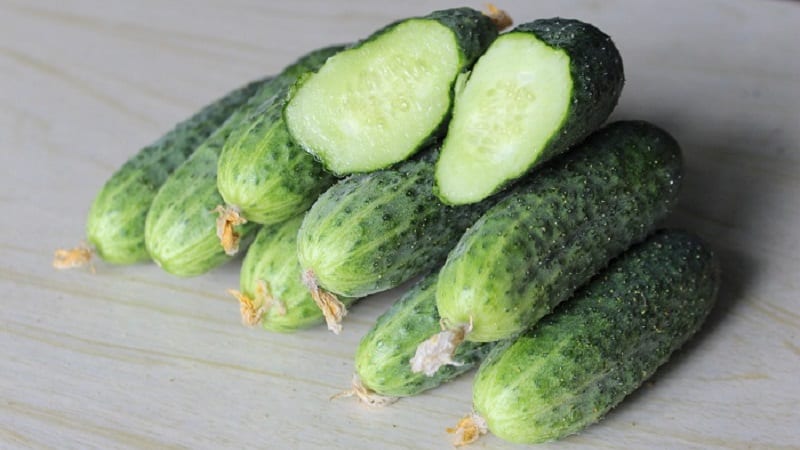
The calorie content per 100 g of product is 10–15 kcal, that is, the product is absolutely dietary. Doctors advise spending a fasting day on cucumbers, during which they eat up to 1–1.5 kg of vegetables.
Nutritional value of fruits:
- proteins - 0.8 g;
- fats - 0.1 g;
- carbohydrates - 3 g.
For your information! When used externally, cucumbers moisturize the skin, whiten imperfections and accelerate cell regeneration.
Alkaline salts in vegetables prevent the formation of sand and kidney stones. Iodine compounds and fiber improve intestinal function.
Characteristics
Bettina hybrid is indeterminate. Ovaries form on the main stem. The lashes are moderately branched. The leaves are medium-light green, but increase in size when grown in a greenhouse. Each leaf axil bears from 1 to 4 fruits. There are more female flowers than male ones.
Length of cylindrical fruits – 10–13 cm, weight – 60–80 g. Cucumbers have large tubercles and black pubescence. The pulp is juicy, crispy, without bitterness or voids. When preserved, the taste properties are not lost.
Important! Bettina F1 is a hybrid, not a variety, so seeds are not collected from your own harvest, as they do not retain the quality of the first generation.
The color of vegetables greatly depends on the frequency of moisture and the quality of the soil.. In good conditions, the skin is a rich dark green color. If the soil is acidic, yellow spots or stripes appear on the fruits.
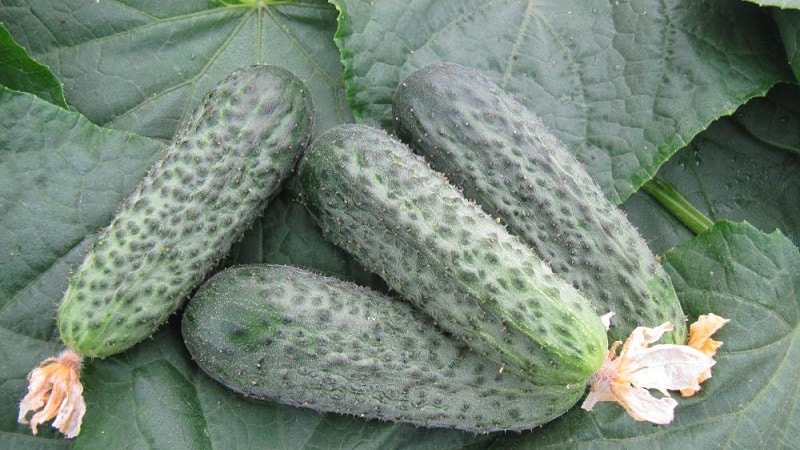
Vegetables ripen in a short time: the first harvest is harvested already 40 days after sowing. When cultivated in open ground From 1 m2 About 5 kg of cucumbers are collected. The quality and quantity of fruits depends on care and the creation of favorable conditions for the growth and development of the crop.
Other “Dutch” for your site:
Time-tested cucumber "Othello"
How to grow cucumbers yourself
Hybrid Bettina grown by seedlings and direct sowing in the ground. In cold areas or to obtain an early harvest, the seedling method is used. In the southern regions, seeds are planted directly into the ground.
Seedling method
Plant the seeds in separate containers (400–500 ml) in late April – early May. Soil for seedlings is purchased at a gardening store or prepared independently using peat, sawdust or river sand, garden soil and humus (1: 1: 1: 1). To disinfect the substrate, pour boiling water over it and bake it in the oven.
 The seed package indicates whether the grains were prepared by the manufacturer. If nothing is said about this, the planting material is processed independently. To do this, place it in a 1% solution of potassium permanganate for 20–30 minutes and wash it under running water. Next, the seeds are germinated: soaked in warm water (+35...+40°C) for 2-3 hours and wrapped in damp cotton cloth until grain-sized sprouts appear. As the fabric dries, moisten it so that the seeds do not float in the water.
The seed package indicates whether the grains were prepared by the manufacturer. If nothing is said about this, the planting material is processed independently. To do this, place it in a 1% solution of potassium permanganate for 20–30 minutes and wash it under running water. Next, the seeds are germinated: soaked in warm water (+35...+40°C) for 2-3 hours and wrapped in damp cotton cloth until grain-sized sprouts appear. As the fabric dries, moisten it so that the seeds do not float in the water.
Seal 1 grain into separate containers to a depth of no more than 2 cm. The soil is moistened carefully with a spray bottle so as not to wash away the soil. To create greenhouse conditions, the container is covered with film. When the first shoots appear, the shelter is removed and the seedlings are placed on a well-lit windowsill. Young plants are grown at a temperature of +23°C during the day, and +16...+19°C at night.
On a note! At temperatures above +23°C, plants will not adapt well to unfavorable conditions and may suffer from cold snap.
Direct sowing
Holes for cucumbers are dug according to the pattern 40x40 cm. Wood ash and humus are placed in each hole. Sprinkle a layer of soil on top, deepen the seeds by 1.5–2 cm.
The crops are moistened and covered with film. When sprouts appear, the covering material is removed. Protect cucumbers from cold weather with cut-off plastic bottles.
Step-by-step cultivation and care
Cucumber Bettina does not require special care, but basic agrotechnical rules are still followed. With regular fertilizing, timely moistening and loosening of the soil, the yield will be maximum.
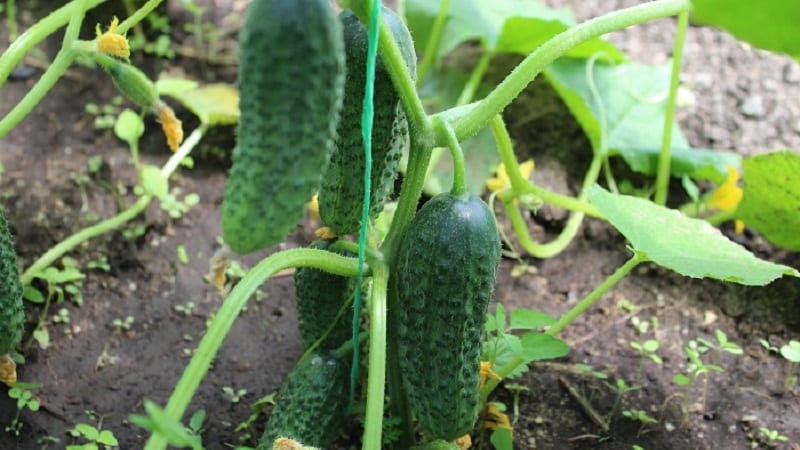
Culture watered with rain or settled water at room temperature. Irrigate the soil so that splashes do not fall on the leaves and stems of the bushes. Some vegetable growers make grooves or holes next to the plants and moisten the cucumbers through them.
On hot days, cucumbers are watered every day. During the fruiting period at 1 m2 use 5-6 liters of water. If it is not possible to moisten the crop daily, this is done every other day, but the volume of liquid is increased by controlling the humidity level. This is especially important in greenhouse structures, where infectious diseases develop at high humidity. For prevention, structures are ventilated by opening windows or doors. 12–24 hours after watering, loosen the soil around the bushes.
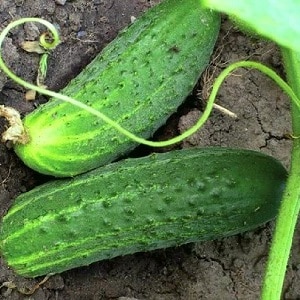 Irrigation is combined with fertilizers: this way nutrients are absorbed more efficiently and quickly. Nitrogen-potassium fertilizing predominates, but during the fruiting period calcium and magnesium are used. The crop is fertilized with bird droppings diluted in water (1:20), mullein (1:10), horse manure (1:10) or wood ash infusion. Nitrophoska or superphosphate are used as complex fertilizers.
Irrigation is combined with fertilizers: this way nutrients are absorbed more efficiently and quickly. Nitrogen-potassium fertilizing predominates, but during the fruiting period calcium and magnesium are used. The crop is fertilized with bird droppings diluted in water (1:20), mullein (1:10), horse manure (1:10) or wood ash infusion. Nitrophoska or superphosphate are used as complex fertilizers.
In open ground, plants do not need serious adjustment of the vines. For good yield, 2-3 lower shoots are removed. The main stem is left untouched, since the fruits are mainly formed on it.
In a greenhouse, staking and lash removal play an important role. during the period of intensive hybrid growth. When the central stem reaches the top of the trellis, it is pinched.
Important! To prevent weeds from taking nutrients and moisture from the cucumbers, weed the beds once a week. The procedure is combined with loosening the soil.
Features of cultivation and possible difficulties
Bettina cucumber is cultivated throughout the Russian Federation. In the southern regions, the hybrid is grown in unprotected soil. In areas with a cool climate, the crop is planted under film covers. In the northern regions, heated greenhouses are used.
Diseases and pests
The hybrid has strong immunity to cladosporiosis, cucumber mosaic virus, downy mildew, highly resistant to powdery mildew. Preventive measures will ultimately reduce the risk of infection.
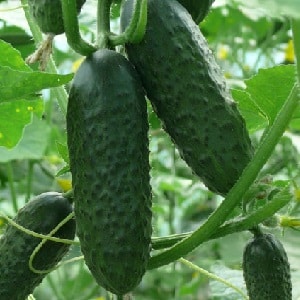 Early ripening cucumbers are not treated with heavy chemicals so that the fruits are safe for humans. Diseases are prevented with organic or mineral solutions:
Early ripening cucumbers are not treated with heavy chemicals so that the fruits are safe for humans. Diseases are prevented with organic or mineral solutions:
- against powdery mildew the leaves are treated with a solution of 30 drops of iodine, 1 liter of milk, 1 tbsp. l. soap and 10 liters of water (sprayed once every 10 days);
- prevention with baking soda mixed in water will protect plants from gray root rot;
- against bacteriosis use “Trichopol” (2 tablets per 1 liter of water).
Cucumbers are often attacked by pests (spider mite and slugs). For prevention, the beds are dug up in the fall and the soil is left to freeze.Garlic or onions are planted between the rows: the pungent smell repels pests.
If spider mites have already settled on plants, they are treated with garlic infusion (200 g of grated garlic or onion are stirred in 10 liters of water, allowed to brew for a day, 200 g of laundry soap are added for stickiness). To prevent slugs, bushes and the soil around them are sprinkled with wood ash.
Harvesting and application
Vegetables are harvested 35–40 days after planting, when the fruits reach 12–13 cm. Harvest cucumbers every day to prolong fruiting. Even if vegetables hang on the bushes for a long time, they do not outgrow or lose their external and taste characteristics.
Important! To preserve the harvest longer, it is immediately placed in the refrigerator, and not in closed plastic bags.
Hybrid cucumbers great for summer salads and any marinades. Small sizes ensure whole-fruit canning. The low seed content in the fruits gives them tenderness and a pleasant taste.
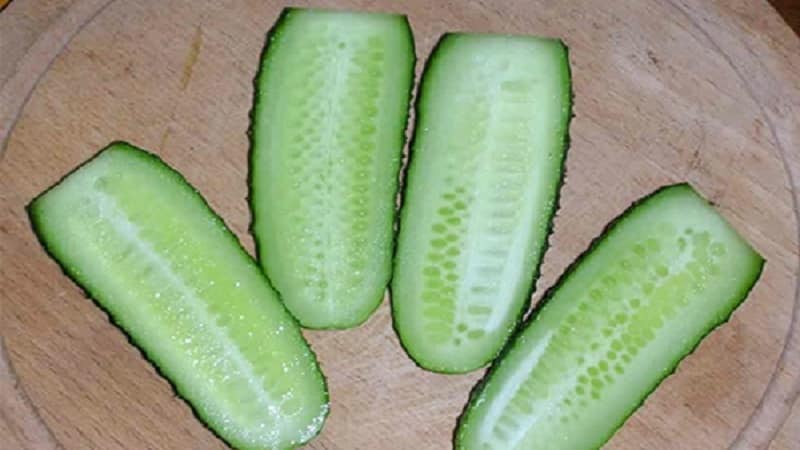
Advantages and disadvantages
Positive qualities of a hybrid:
- quick yield of the crop;
- ease of care;
- disease resistance;
- growth under unfavorable conditions, in shaded areas;
- high productivity;
- the versatility of vegetables in cooking;
- long fruiting;
- excellent taste;
- good presentation;
- transportability over long distances without loss of presentation or taste.
Flaws:
- high cost of seeds;
- the impossibility of collecting grains from one’s own harvest for further sowing.
Reviews
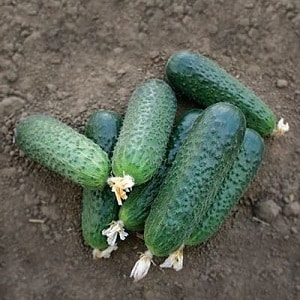 Vegetable growers prefer this hybrid due to its advantages. Bettina is grown in many regions of Russia:
Vegetable growers prefer this hybrid due to its advantages. Bettina is grown in many regions of Russia:
Victoria, Izhevsk: “Five years ago I was choosing cucumber seeds in a gardening store.The seller advised me to purchase a Bettina hybrid. Since then, every season I have grown 5 plants of these delicious cucumbers. This is an early crop, so we harvest before our neighbors. Vegetables taste great both fresh and in winter preparations. Many people say that varietal cucumbers are more juicy, but I prefer early-ripening hybrids: they do not require special care and are highly resistant to diseases. I will continue to grow it".
Elena, Nizhny Novgorod: “I tried many varieties and hybrids of cucumbers in my own experience, until my neighbors at the dacha advised me to plant Bettina F1. Now I only grow this cucumber, always through seedlings. Planting and care do not take much time and effort. The crop begins to bear fruit in early July. Plants practically do not get sick. The fruits are beautiful, as in the photo of the package with seeds. Cucumbers are delicious, aromatic, dense and homogeneous inside. Suitable for pickling and marinade. For the winter I can preserve salads with the addition of these fruits. I like the Bettina hybrid. I advise everyone!".
Conclusion
The early hybrid Bettina F1 produces a tasty and healthy harvest already 35–40 days after sowing. During transportation, vegetables do not lose their appearance and taste characteristics. Cucumbers are added to the diet fresh, canned and pickled for the winter.
The Dutch hybrid quickly gained popularity among gardeners due to its unpretentiousness in care, resistance to different weather conditions and strong immunity to major crop diseases.